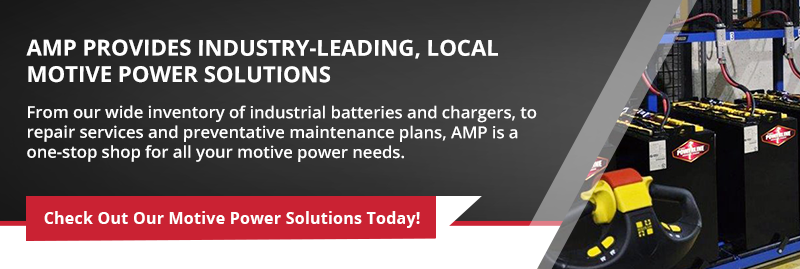Charging industrial forklift batteries sounds easy at first—just slap the battery onto the charger whenever it gets low, right? Well, if you want to get the best performance out of your warehouse forklifts’ industrial batteries, there’s a bit more to an effective forklift battery charging procedure than just topping off the charge whenever the battery gets low.
To improve forklift battery charging safety and efficiency while also increasing the useful life of each battery, here are a few things that you should know about charging your forklift batteries:
Most Industrial Forklift Batteries Are Good for around 1,500 Charging Cycles
Each and every forklift battery ever made has a finite number of times it can be charged. Once a battery has reached its limit, you’ll notice that it won’t charge to full the way it used to and may not achieve its proper amperage. This can negatively impact the performance of your forklifts and even cause damage to electric forklift systems.
Because of this limited shelf life, it’s important to have a maintenance plan for your forklift equipment that includes phasing out aging batteries before they fail. How often should you replace an industrial battery? If the battery is good for 1,500 charging cycles, then that translates to about five years of useful life if you charge it once a day. So, replacing your forklift batteries once every five years should be sufficient to ensure you get the most use out of your batteries while minimizing your total cost of ownership for them.
You Should Avoid Opportunity Charging if You Want To Maximize Your Forklift Battery Life
As mentioned above, a battery can only endure so many charging cycles before it starts to degrade. It doesn’t matter whether you start the charging cycle at 80% power, 50% power, or 25% power—it will still reduce the total number of charges the battery can withstand. The practice of “opportunity charging,” or recharging the battery whenever it happens to be convenient, can dramatically shorten a battery’s useful life.
For example, say your battery is able to take 1,500 charges. At one charging cycle a day, that battery should last for five years. If you charge it twice a day under an opportunity charging method, the battery will now only last two and a half years.
Warehouse Forklifts Should Have Their Batteries Recharged When at 20-30%
While you may want to avoid opportunity charging, you’ll also want to avoid letting your forklift batteries get depleted. Typically, it’s best to recharge a forklift’s battery before it drops below 20% charge—e.g. the “red” zone. If you let a battery deplete too much before charging it, that could have negative effects on the battery’s performance in the future.
However, to avoid wasting battery charge, it might be best not to charge it too early. Starting the charge cycle somewhere between 20% and 30% charge remaining might provide the ideal balance of battery life, performance, and downtime. Also, remember to let the battery reach 100% charge before attempting to remove it from the charger.
Proper Charging is Key to Preventing Sulfated Forklift Batteries
Lead acid forklift batteries are prone to suffering a buildup of lead sulfate crystals. As lead batteries discharge, the lead material on the plate reacts with sulfate from the electrolyte—leading to the formation of a lead sulfate residue on the plate. This can deplete the battery’s charge by draining the battery of its lead active material and sulfate from the electrolytic fluid in the battery.
This sulfate buildup can, if ignored, harden and create an electrically-resistant surface that impairs the battery’s performance—or, may even render it unusable.
To avoid sulfated batteries, it’s important to avoid letting batteries remain in a depleted state for too long. Additionally, it’s important to routinely inspect the battery’s electrolyte levels to ensure they aren’t depleted as well.
Choosing the Right Forklift Battery Charger
When you choose a forklift battery charging system for your motive power needs, be sure to select one that is right for your needs. This means:
- Choosing an Industrial Battery Charger with the Right Amp Hour (Ah) Rating. Using a battery charger with an incompatible amp hour rating can contribute to sulfated batteries. So, it’s important to check the amp hour rating to optimize the useful life of your industrial batteries.
- Considering the Dimensions of Your Batteries. For optimum performance, it’s important to use a battery charging system that will fit your batteries. Odds are, charging systems made by a given manufacturer for their industrial batteries should fit, but be sure to check whether the chargers are compatible with batteries of the size (or sizes) that your forklifts use.
- Thinking about How You Want to Optimize Your Battery Charging Schedule. Different battery charging systems will fit different forklift battery charging procedures. When looking at charging systems, consider whether you want to emphasize charging speed, energy efficiency, or battery useful life as your top priority since different motive power products will emphasize different performance characteristics.
Need help finding the right forklift battery charging solution or a reconditioned forklift battery? Contact the experts at Southern States Motive Power for more information about forklift battery charging procedures and general warehouse equipment solutions.






